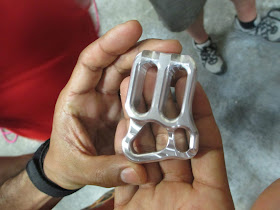In their quest to create "something new," they have developed an autoblocking device (like a Petzl Reverso or the Black Diamond ATC Guide). They have affectionately named the new device, the Spire. In their quest to make their device the best on the market, they invited a group of AAI guides in two waves to come out to their factory and test it.
As you're likely aware, autoblocking devices have become standard equipment for multi-pitch leaders. Most companies have some kind of device they offer. However, in one key way, the devices are very much the same. It is difficult to complete a lower with them when they are in guide mode. We did a blog on this last year, to check it out, click here.
The innovation behind the Spire is that it has two holes in the area the I refer to as the fin. In most of these devices there is only one. One of the holes is for clipping the device into a powerpoint, while the other hole is for a spare carabiner. When the device is loaded, you can insert a spare carabiner into the second hole and crank on it sideways. This allows the pinched rope to release, allowing the person being belayed to lower.
A prototype of the Spire
On the first trip up to the factory, AAI program coordinator Tim Page, AAI guide and equipment shop manager, and AAI Guides' Choice manager, Jeff Voigt tested the device and found it lacking. It appeared that the slots were too wide which caused some problems with rope movement.
When Jeff Voigt, Richard Riquelme, James Pierson and I returned, they had fixed this problem and the device was relatively smooth.
The Spire in Autoblock Mode with the Release Carabiner on the side.
The Spire loaded with a rope with the Release Carabiner on the side.
Using the Release Carabiner to lower.
As we began to experiment with the device, we ran through a number of scenarios. In most cases, the device worked admirably.
AAI Guide Richard Riquelme studied engineering in school, and his inner geek kicked in during the tests. He was able to spot a number of places on the device where a millimeter of additional width here, and a millimeter less of material there would make the device smoother.
Richard belaying James on the wall at the SMC factory.
James testing the device.
In the process of testing, I decided that I would try something that really doesn't work with any of the competitions devices. I decided to try to lower two climbers at once, each on different ropes, using the release carabiner. Not only did it not work, but I bent the prototype and got the carabiner welded into one of the holes.
They had to cut the carabiner out to continue the tests.
The carabiner welded in the Spire.
The reality is that this new device could be a game-changer in the autoblocking world. It works significantly better than many of its competitors and as the folks as SMC continue playing with its design, the device will just get better.
Once we completed our tests, we were taken on a little tour of the factory.
The desk where carabiners are put together.
A worker using a drill press to finish edge rollers for the rescue services.
Carabiner Parts
I was impressed by SMC. They build everything in the United States, which is rare these days, and they do a great job. Just the fact that they brought us in to give them feedback on their new device is admirable.
And I'm really looking forward to the official release of the Spire...
--Jason D. Martin











Thanks for keeping us in the loop! Good job with your thorough testing and input - it's awesome to hear about a company including the community experts in it's RnD and testing phases.
ReplyDelete